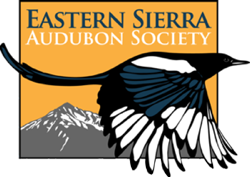2008 Birding Articles by Tom and Jo Heindel
- The New Owens Lake Hosts New Birds (Jan/Feb 2008)
- Winter Birds in the Eastern Sierra (Mar/Apr 2008)
- Kingbirds of Inyo County (May/June 2008)
- Loons of Inyo County (Sept/Oct 2008)
- Inyo County Longspurs (Nov/Dec 2008)
Jan/Feb 2008: The "New" Owens Lake Hosts "New" Birds
[Originally appeared in the Siera Wave newsletter, Vol. 26, No. 3, Jan-Feb 2008 - click here for original with photos]
Each season brings avian surprises and this fall was no exception. Four species were found that had never been documented before in Inyo County and it should be no surprise that all four were found at the new Owens Lake. The habitat being restored has not been seen there for over a century and clearly supports the adage Build it and they will come. Because of ongoing construction the lake is not open to the public but several trained people are authorized to conduct shorebird surveys to document the impact of dust control measures on birds. These surveys, conducted every few days during spring and fall, are revealing the lakes avian secrets. It is hoped that after construction is finished some level of access will be returned to the public.
Ornithologically speaking fall is primarily August through November, the main time most birds are moving south, although a few do start earlier. All four additions were photographed, which is supporting evidence of the validity of the identification. Two of the species are sufficiently rare in the state that they will be reviewed by the California Bird Records Committee.
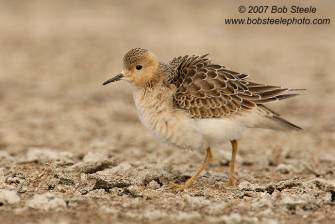
Buff-breasted Sandpiper, Photo by Bob Steele
Mike Prather organizes authorized field trips to the lake and on the August 26th trip all participants were treated to a juvenile Buff-breasted Sandpiper found by Susan Steele. Buffies breed in northern Alaska and across the Canadian arctic and winter in southern South America. Most California records are grouped from late August through mid September.
On 30 August a juvenile Black Turnstone was found by Mike SanMiguel and remained for at least three days. This species, usually found along the Pacific Coast with only a few inland records, is more unusual inland in fall than in spring.
On 16 September a juvenile Curlew Sandpiper was found by Susan Steele. This species breeds in Siberia and winters in the Old World from Africa, through southern Asia to Australia. It has been seen in California about 36 times before this sighting; most records are along the coast, usually in fall, while the few interior records are usually in spring. This sighting is unofficial until accepted by the CBRC.

Lesser Black-backed Gull, Photo by Bob Steele
On 18 Nov a second cycle (immature) Lesser Black-backed Gull was found by Susan Steele. This species breeds across Europe and west to Iceland and has become a regular wintering species at the Great Lakes, mid Atlantic states, and Southeast. Since the mid 1990s it has been recorded annually in California primarily mid September to late March with most after mid October. There are 31 state records with ten more under review not including this bird, which remains unofficial until accepted by the CBRC.
As if the fabulous four werent enough, Inyo was also treated to other slightly less rare species like three different American Golden-Plovers (2nd, 3rd, and 4th county records), a juvenile male Ruff (4th county record), an immature Long-tailed Jaeger (4th record), and a juvenile Ruddy Turnstone (11th county record). It is not surprising that all of these sightings occurred at Owens Lake as well. While the avian significance of this countys crown jewel will continue to grow as long as LADWP continues to enhance and maintain wetlands habitat there as a result of required dust control mandates, it will be a long time before it returns to its former status.
Mar/Apr 2008: Winter Birds in the Eastern Sierra
[Originally appeared in the Siera Wave newsletter, Vol. 26, No. 4, Mar-Apr 2008 - click here for original with photos]
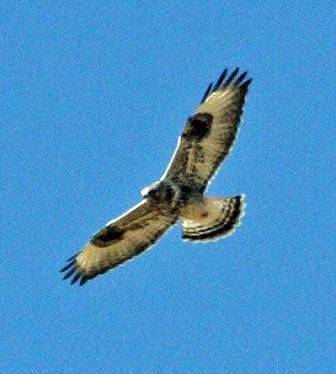
Rough-legged Hawk, Photo by Debby Parker
Winter brings a suite of birds from the north that are not seen the rest of the year, such as Tundra Swans, Greater White-fronted, Snow, Rosss, Cackling and Canada Geese, Bald Eagles, Rough-legged Hawks, and Northern Shrikes. Tundra Swans are found from early November to mid March in numbers that vary from year to year with daily averages of 10-60 birds. Some years over 100 have been seen but the maximum is 202 (31 Dec 1997 at Klondike Lake and Tinemaha Reservoir). This year there were fewer birds than expected. While the geese are migrants as well as winter visitors, there are birds that, once they find a location to their liking, will spend the winter trying to avoid hunters and photographers. Most numerous are Snow and Canada Geese with Greater White-fronted, Rosss, and Cackling Geese less common, usually fewer than ten but occasionally more.
Bald Eagles are on everyones Wish List and they seldom disappoint. Most arrive in early November and have been seen through April, although they are not easily found after mid March. Most records are 1-2 birds but often 3-4 are seen. Seventeen were reported on the Eastern Sierra January 2008 Eagle Survey, the same number as last year but a different combination of adults and immatures (8 adults and 9 juveniles versus 11 adults and 6 juveniles in January 2007).
The Rough-legged Hawk is an enigma. In the 1970s it was often seen in numbers greater than Red-tailed Hawks, sometimes 8-10 birds in a day. In the last two decades 1-2 birds are usually reported the entire winter although when scarce in the Eastern Sierra there are reports of many more in the Bridgeport and north areas. This past December on the Bishop Christmas Count, 2-3 were seen. One party (Kristie Nelson) saw an adult male and the other party (Jon Dunn and Debbie House) had an adult male and juvenile. It is problematic if the parties saw the same adult male since the two locations are somewhat near each otherthen again, they could have been different birds.
Northern Shrikes are rarely reported November through February and all but one record are of single birds; the exception is two birds at different locations, but within flying distance, that may have been one bird moving around. This year one was reported at Big Pine in late December impaling a goldfinch (Earl & Eliot Gann).
The second group of wintering birds is normally seen in the nearby mountains during the year but some winters they can be found on or near the valley floor. Examples are jays, nuthatches, rosy-finches, and chickadees. This has been an excellent winter for some of these lowland invaders, especially Mountain Chickadees, with fewer reports of Stellers and Western Scrub-Jays. Nuthatch and rosy-finch reports have been few but one deep snowfall could change that! It is easy to assume that these species have descended from our nearby Sierra Nevada but that may not be the case since these species are found well north into Canada and are known to leave their homeland if there is a food supply failure. Some years the chickadees or jays at your feeder may be from British Columbia, not the Sierra!
Every winter also provides surprises, this year a Short-eared Owl in Deep Springs Valley (Chris McCreedy). Again, it is not known from where this bird came. Is it a resident from the marshes at Deep Springs Lake, or a visitor from the north, or an early migrant?
We are mindful that the more we learn about the birds of the Eastern Sierra the more we are aware of how much more we dont know. Winter isnt over, ornithologically speaking, until the end of February so there is time for more birds to appear providing more opportunities to discover just how much more there is to learn about winter birds in the Eastern Sierra.
As the radius of knowledge extends, the circumference of ignorance expands. [Attributed as a Japanese saying]
May/June 2008: Kingbirds of Inyo County
[Originally appeared in the Siera Wave newsletter, Vol. 26, No. 5, May-Jun 2008 - click here for original with photos]
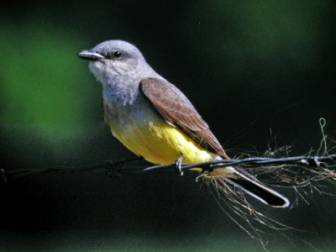
Western Kingbird, Photo by Jo Heindel
There are 400 species of Tyrant Flycatchers, family Tyrannidae, all found only in the New World. The kingbirds belong to the genus Tyrannus, one of fifty-two genera that make up the family. Ten species in Tyrannus are found in the U.S. and six of those have been reliably documented for Inyo County.
The most common kingbird in the Eastern Sierra is the Western Kingbird, Tyrannus verticalis. It migrates throughout most of Inyo County and breeds annually in the Owens Valley towns and ranches as well as Deep Springs College. Arriving in April, they set up their territories in towns, often using electrical boxes as nest platforms, and in cottonwoods at ranches. They regularly begin singing before daylight with an electrical song that resembles a tape recorder playing on fast forward. Early in the breeding season they may sing all night long eliciting amazement from some people and anger from others. When they have nests with young they attack any and all birds, people, and cats and are vigorous defenders against much larger birds like jays, crows, ravens, and even hawks that try to predate their young. By September most have departed for their wintering grounds from Mexico to Costa Rica where the insect supply is bountiful. Don Nikolaus, a Big Pine old-timer, called this bird Bee Martin as a youth, since bees are a prime prey item in the Owens Valley.
The other breeding kingbird in Inyo County is the Cassins Kingbird, Tyrannus vociferans, which has bred at Deep Springs College but not annually. There are a few countywide reports of migrants in areas inappropriate for breeding but any sighting of this species is noteworthy and should be reported with substantiating details to the Eastern Sierra Birds website. During the fall when birds are molting, a kingbird without white outer tail feathers is not necessarily a Cassins since that is the time when a Western can lack the otherwise distinctive tail feathers. Attention should be directed at the contrast and colors of the cheek, throat, breast, back, and wings.
The Eastern Kingbird, Tyrannus tyrannus, unsurprisingly, is primarily an eastern kingbird but regularly wanders west and breeds in eastern Oregon and eastern Washington. There are over one hundred records for Inyo County with most birds reported mid May to early June.
The Scissor-tailed Flycatcher, Tyrannus forficatus, is a kingbird since it is in the kingbird genus but for reasons known only to a few, and not us, its common name remains flycatcher. This species is found most regularly in southcentral U.S. but has been found twenty-one times in Inyo County with sixteen records between late April and early June and five scattered from late July to late October.
The Tropical Kingbird, Tyrannus melancholicus, is usually found in the New World tropics but has been recorded along the West Coast in fall and winter. There are two records for Inyo County with one at Furnace Creek Ranch, Death Valley National Park, in late May and another photographed at Panamint Springs, Death Valley National Park, in mid September.
The Thick-billed Kingbird, Tyrannus crassirostris, a tropical species usually found from Mexico to southeastern Arizona and southwestern New Mexico, made it to Inyo County once. Its appearance in Lone Pine on 24 December 1991 was a very fancy Christmas present for the many birders who saw it. No one could have predicted that it was going to remain through 1 April 1992 since the insects it normally eats disappear during the winter. The temperatures dropped into the teens but it survived by snuggling up to a nearby greenhouse for added, although not tropical, warmth and when the ambient temperature increased a little it would fly out to a perch over a bee hive and wait for the bees to exit the hive to drink nectar out of a dish placed at the edge of the hive. Few bees made it to the dish, much less back inside!
Two other kingbirds have been reported in the state, each only one time. A Couchs Kingbird wintered in southern California and a Fork-tailed Flycatcher spent early September in Sonoma County (another Fork-tailed sighting in Sutter County is under review by the California Rare Birds Committee). Needless to say, the phones will be ringing off their hooks if any kingbird, other than the expected species, shows up in the Eastern Sierra!
Sept/Oct 2008: Loons of Inyo County
[Originally appeared in the Siera Wave newsletter, Vol. 27, No. 1, Sept-Oct 2008 - click here for original with photos]
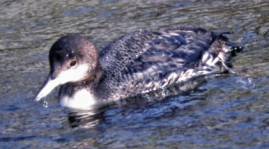
Common Loon, Photo by Tom & Jo Heindel
There are three species of feathered loons that occur in Inyo County and untold numbers of the unfeathered kind. Most often recorded is the Common Loon, an uncommon spring and fall migrant and casual summer and winter visitor. Spring migrants are expected in early April and most have moved north by late May but lingerers have been found through early June. Usually 1 to 2 birds are seen, occasionally 3 to 4, but the spring maximum is 19 alternate-plumaged birds in a tight flock seen at Tinemaha Reservoir on 10 Apr 1975 on a rainy, early evening (T&J Heindel), behaving as though they had just arrived. Fall migrants begin to arrive in mid Sep but most move through from mid Oct to early Dec. Again, most sightings are 1 to 2 birds, but 3 to 4 are seen more often than in spring. The fall maximum is 16 birds in a flock at Haiwee Reservoir on a very windy day on 19 Nov 1996 (T&J Heindel). Windy days and days after strong winds provide the conditions whereby the birds drop into water bodies rather than fight the difficult conditions aloft. Winter birds average a sighting every other year, usually in January or February and there are three summer records, a pair at Tinemaha Reservoir 5 Aug 1989 (M.A. Patten), another pair at Tinemaha Reservoir 8 July 2003 (T&J Heindel) that responded to an imitated call by calling back, and a single bird at Second Lake, west of Big Pine 15 Jul 2008 (D. Holway), which set a county high elevation record!

Pacific Loon, Photo by Tom & Jo Heindel
The next most numerous loon is the Pacific Loon, a rare fall migrant recorded almost fifty times, with the vast majority of records from the Owens Valley where there are many more reservoirs, lakes, and ponds. Most birds move south from early Oct to early Dec although there is an avant garde in late Sep and a tail-end Charlie in mid Dec. Almost all sightings are of single birds but there are several records of two birds and the maximum is three seen at Tinemaha Reservoir 5 Nov 2001 (J.L. Dunn). There are two spring records, both in May (J.L. Dunn; M. Brady, S. Glover, M. Prather). This lopsided seasonal distribution is the result of most of the arctic breeders heading west to the coast and then south to their wintering areas along the Pacific Coast to Mexico. But some birds head south and then move west to the coast leaving a sprinkling of records scattered over most of the western states to mark their passage. It is not known why there are so few spring records in the county but it could be because the birds remain along the coast and move north before turning east or they may head east from the coast and overfly the county completely.
The Red-throated Loon has been recorded eleven times in the county, all single birds and almost all seen in Nov. The earliest arrival is 9 Oct which corresponds with the rest of the state but it is an outlier in the Eastern Sierra and the eastern desert of Kern County. The latest record is 28 Dec 2002 (T&J Heindel) excluding a bird that arrived at Diaz Lake 21 Dec 1992 that was last seen 10 Jan 1993 (J.L. Wickman). All county records are since 1990 and likely reflect the increased birding coverage since then rather than a change in the distribution of this species.
A loon to be looked for is the Yellow-billed Loon, which has been recorded in Mono County 8 Dec 1976 (D. Gaines) and reported in late February 1976 at Tinemaha Reservoir (T&J Heindel), although not adequately documented to be included as a county record. A pattern of interior records indicates a window from mid Oct to early May with most records occurring Dec to Feb.
Field guides adequately depict the plumage differences between loons with basic plumage being the most similar looking between the species but each has distinct characteristics that clinch the identification. Bill size, shape and color, neck pattern, and floating posture will usually make a well-seen loon an easy call. Once you become proficient in loon identification you just may become a loon lover, also known as a loonie!
Nov/Dec 2008: Inyo County Longspurs
[Originally appeared in the Siera Wave newsletter, Vol. 27, No. 2, Nov-Dec 2008 - click here for original with photos]
Longspurs are a small group of small LBJs, a.k.a. “little brown jobs,” closely related to sparrows in the family Emberizidae. They get their name from the long hind claw they and Horned Larks have. There are four species in North America with the Lapland and Smith’s breeding in Alaska and Canada and the McCown’s and Chestnut-collared in the northern Great Plains. Winter finds all but the Lapland in the south-central states; the Lapland prefers the northern tier states as well as the Pacific Coast. All four longspurs have been documented in the eastern Sierra.
During the breeding season, males are brightly colored and distinctive but when they occur in our area they seldom have bright feathers to help in identification. This task is not for the faint-hearted as recognized by Allen R. Phillips, a famous ornithologist, who advocated a half century ago that the best way to identify them was with a 12-gauge shotgun! Fortunately we have learned much since those days and now know what, where, and when to seek as well as what they sound like as they call while flying overhead.
The Chestnut-collared Longspur is an uncommon fall migrant and casual, less than annual, winter visitor and spring migrant to the eastern Sierra. The vast majority of records are from late September to early December with an early outlier on 5 Aug (M.A. Patten, American Birds 44:165). Since the species was first recorded in Inyo County, 28 Sep 1917 near Darwin (Grinnell, Condor 20:87), it has been recorded all months except June and July…when they are bright and pretty!
The Lapland Longspur is a very rare fall migrant with about fifty records most in October and November plus two in winter and two more in spring. The earliest fall record is a photographed bird 12 Oct (2008 at Owens Lake, T&J Heindel). This is only one day earlier that the first time it was ever recorded in Inyo County on 13 Oct 1949 at Deep Springs Lake (McLean, Condor 71:434).
The McCown’s Longspur has been recorded just six times since it was first found in Inyo on 16 Oct 1949 near Deep Springs Lake (ibid.). All records are between 16 Oct and 11 Nov. The last one added to the county list was ten years ago when Andrew and Leah Kirk found and we photographed it east of Independence.
The Smith’s Longspur, a casual vagrant, is represented by a single record when it was viewed and photographed by the most active birders in the state from 4-11 Oct 1997 at Furnace Creek Ranch.
So how do you find longspurs? Know when to look – October and November are optimal. Know where to look – primarily grasslands, cut alfalfa fields, dry lakebeds and golf courses. Know what to look for – primary extension, bill size and shape, tail pattern, wing covert color, breast color and streaking. The Sibley Guide and the National Geographic Field Guide to the Birds of North America both discuss identification characteristics of each species well. Know the calls – Chestnut-collareds give a distinctive “kittle-kittle” while Laplands give a descending “tew” as well as a rattle. All four longspur vocalizations are on “Bird Songs of the Rocky Mountain States and Provinces” by Righter and Keller. If you see flocks of Horned Larks, look and listen carefully since longspurs hobnob with the other “long, hind claw species.” This chunkier bird often flies to the side or above the larks. Know the calls and listen for a different call or look for white flashes in the tail as the flock whirls. If you find a rare longspur be ready and willing to validate it by immediately notifying others with more experience and photographing it if possible.
